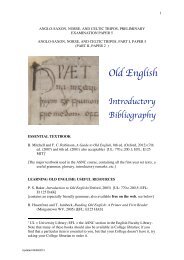Scandinavian history in the Viking age - Department of Anglo-Saxon ...
Scandinavian history in the Viking age - Department of Anglo-Saxon ...
Scandinavian history in the Viking age - Department of Anglo-Saxon ...
Create successful ePaper yourself
Turn your PDF publications into a flip-book with our unique Google optimized e-Paper software.
<strong>Scand<strong>in</strong>avian</strong> History <strong>in</strong> <strong>the</strong> Vik<strong>in</strong>g Age<br />
On Norse traditions <strong>in</strong> <strong>the</strong> Irish sea area <strong>in</strong> <strong>the</strong> late eleventh century, and some <strong>in</strong>terest<strong>in</strong>g discussion <strong>of</strong><br />
royal genealogies, see:<br />
[E88] J. Jesch, ‘Norse historical traditions and <strong>the</strong> Historia Gruffud vab Kenan: Magnús berfœttr and<br />
Haraldr hárfagri’, Gruffudd ap Cynan: a collaborative bibliography, Studies <strong>in</strong> Celtic <strong>history</strong> 16, ed.<br />
K.L. Maund (1996), 117-47 [UL 485:2.c.95.97]<br />
The late eleventh century<br />
The late eleventh century seems to have been a period <strong>of</strong> fairly rapid development <strong>in</strong> Norway, with<br />
urbanisation and <strong>the</strong> Church beg<strong>in</strong>n<strong>in</strong>g seriously to flourish (L200 ff., N230 ff.). For <strong>the</strong> cont<strong>in</strong>u<strong>in</strong>g<br />
‘Vik<strong>in</strong>g’ activity <strong>in</strong> <strong>the</strong> west, see:<br />
[E90] R. Power, ‘Magnus barelegs’ expeditions to <strong>the</strong> west’, Scottish historical review 65 (1986), 107-32<br />
The twelfth century<br />
For <strong>the</strong> twelfth century and <strong>the</strong> onset <strong>of</strong> <strong>the</strong> civil wars so deplored by some mediaeval authors, <strong>the</strong><br />
general guides above (A35, E1 ff.) are <strong>the</strong> best start<strong>in</strong>g po<strong>in</strong>t. For a review <strong>of</strong> <strong>the</strong> possible causes that led<br />
to <strong>the</strong> civil war, see:<br />
[E91] B. Sawyer, ‘The ‘civil wars’ revisited’ NHT 82 (2003), 43-73<br />
<strong>the</strong> standard textbook on early mediaeval Norway rema<strong>in</strong>s:<br />
[E95] K. Helle, Norge blir en staat 1130-1319, 2nd edn, Handbok i Norges historie 3 (1974) [UL<br />
593:01.c.1.103]<br />
K<strong>in</strong>gship and succession<br />
The prevalence <strong>of</strong> jo<strong>in</strong>t k<strong>in</strong>gship <strong>in</strong> eleventh- and twelfth-century Norway is strik<strong>in</strong>g, as also are <strong>the</strong><br />
attempts to historically ‘legitimise’ <strong>the</strong> Norwegian royal house back before sa<strong>in</strong>t Olaf Haraldsson with<br />
reference to Harald fairhair (E30 ff.). It has been argued that <strong>the</strong> role <strong>of</strong> Harald is so heavily emphasised<br />
<strong>in</strong> k<strong>in</strong>gs’ sagas to provide a justification for royal landhold<strong>in</strong>g <strong>in</strong> <strong>the</strong> mediaeval era.<br />
[E100] N. Bjørgo, ‘Samkongedøme kontra e<strong>in</strong>kongedøme’, NHT 49 (1970), 1-33 (E.s.) and S. Bagge,<br />
‘Samkongedømme og enekongedømme’, NHT 54 (1975), 239-74 (E.s.)<br />
[E101] J. Jochens, ‘The politics <strong>of</strong> reproduction: medieval Norwegian k<strong>in</strong>gship’, American historical<br />
review 92 (1987), 327-49<br />
[E102] C. Krag, ‘Norge som odel i Harald hårfagres ætt: et møte med en gjenganger’, NHT 68 (1989),<br />
288-302 (E.s.)<br />
[E103] H. Bjørkvik, ‘The Norwegian royal lands <strong>in</strong> <strong>the</strong> middle <strong>age</strong>s’, CM 5 (1992), 7-26<br />
F. SWEDEN<br />
The <strong>history</strong> <strong>of</strong> Sweden <strong>in</strong> <strong>the</strong> Vik<strong>in</strong>g <strong>age</strong> stands alone due to <strong>the</strong> almost complete absence <strong>of</strong> written<br />
sources. This comb<strong>in</strong>ed with <strong>the</strong> unevenness <strong>of</strong> archaeological research <strong>in</strong>to <strong>the</strong> various regions means<br />
that a general overview <strong>of</strong> Swedish <strong>history</strong> is as yet unwritten, and this is reflected <strong>in</strong> <strong>the</strong> items cited here;<br />
for a fairly complicated attempt, (F8).<br />
General surveys<br />
[F1] H. Hildebrand, Sveriges medeltid: kulturhistorisk skildr<strong>in</strong>g, 3 vols plus Register, ed. S. Tunberg<br />
(1884-1903, 1953) [UL 596:4.b.85.1-4]; still a full and classic study<br />
[F2] B. Nerman, ‘The foundation <strong>of</strong> <strong>the</strong> Swedish k<strong>in</strong>gdom’, SBVS 10 (1919-27), 113-31 and B. Nerman,<br />
Sveriges rikes uppkomst (1941) [UL 595:2.c.90.6]; Nerman’s work is now heavily dated<br />
[F3] T. L<strong>in</strong>dkvist, ‘Swedish medieval society: previous research and recent developments’, SJH 4<br />
(1979), 253-68<br />
[F4] E. and H. Patzelt, Schiffe machen Geschichte: Beiträge zur Kulturentwicklung im vorchristlichen<br />
Schweden (1981) [UL 596:3.c.95.6]<br />
[F5] W. Holmqvist and E. Nylén, ‘Schweden und die schwedischen Stämme’, (J3):173-212<br />
80







